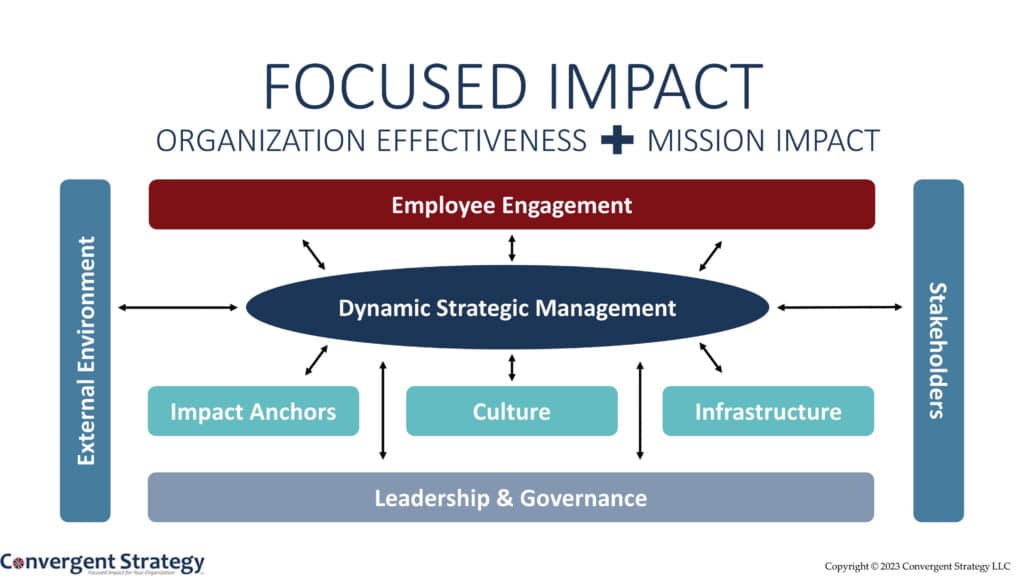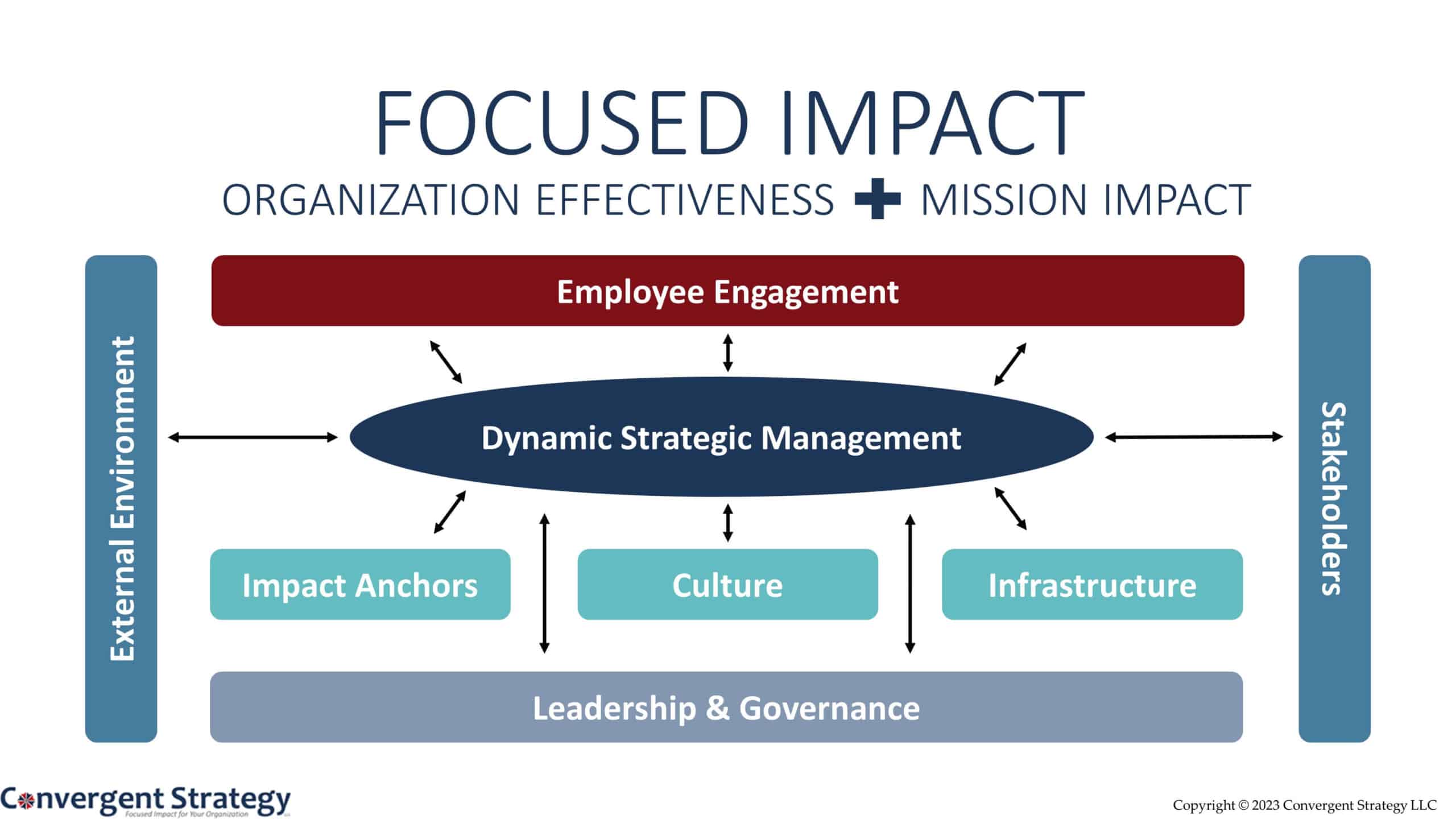Today’s nonprofit organizations are facing greater challenges than ever before. Due to the pace of change, increasing donor expectations to prove impact, and fighting the losing battle of limited resources, many nonprofit organizations struggle to meet the demands and expectations of the people they exist to serve. These challenges leave leaders feeling uncertain about how to enhance their organization’s effectiveness and maximize mission impact. Most probably lose sleep because they feel a tremendous responsibility to reach the people their organization exists to serve while juggling the competing and sometimes contradictory demands of their donors, board, and employees. These competing demands and the constant change nonprofits experience make it difficult to maintain focus.
Most of us have heard Gallup’s statistics, more than half of employees today have left jobs because of a boss. Less than one-third of US employees are actively engaged at work[i]. 60-80% of change efforts fail or fall short, likely due to complacency or resistance to change[ii]. On the other hand, employees that are highly engaged and working for leaders who intentionally engage employees are much more likely to stay with an organization, almost two times more productive compared to their disengaged peers, and challenge themselves to improve[iii,iv]. When nonprofit organizations achieve high levels of employee engagement they multiply their workforce’s ability to perform mission critical work, creating an environment where resources go much further.
Organizations get the most out of this engagement by creating strategic focus through the discipline of dynamic strategic management. Many organizations are unable to maintain strategic focus because of limited resources and the competing priorities for everyone in the organization. Strategic planning often does little to enhance effectiveness, is often viewed as a feel-good event, or is rolled out through a senior leadership vacuum that stops short of changing the way the organization prioritizes work. Organizations that develop the discipline of dynamic strategic management focus on the few things that it must do to enhance effectiveness while saying ‘no’ or ‘not yet’ to things they could do[v].
When organizations unleash the powerful combination of employee engagement and dynamic strategic management, they achieve Focused Impact. Focused Impact should be the goal of every organization because it maximizes both organization effectiveness and mission impact.
The Focused Impact Organization Model, and corresponding assessment, helps organizations evaluate various elements that must be aligned to maximize organization effectiveness and mission impact. The model not only shows how important employee engagement and dynamic strategic management are to Focused Impact, it also depicts the importance of alignment between all organization elements. If all elements are aligned, then effectiveness and mission impact might even be greater than thought possible.
The Focused Impact Organization Model shows the elements that must be in alignment to maximize effectiveness and mission impact:

With a focus on employee engagement as the most tangible driver of organization effectiveness and mission impact, the model utilizes the discipline of dynamic strategic management to maintain strategic focus and ensure the organizational elements are in continuous alignment:
- Employee Engagement – The most tangible driver of organization effectiveness and mission impact. Employees who feel a tangible and personal connection to the organization’s mission are needed today to achieve focused impact.
- Dynamic Strategic Management – the discipline of dynamic strategic management creates and sustains strategic focus and alignment.
- Leadership and Governance – Humble, servant-minded leadership alongside sound leadership and governance practices set the foundation for focused impact.
- Impact Anchors – The organization’s mission, vision, core values, behavior-based core values, and strategic pillars depict why an organization exists and what an organization is trying to accomplish.
- Culture – An organization’s culture is often over-simplified and easily misunderstood, as a result, culture can fuel focused impact when it is fully aligned with organization’s strategic direction.
- Infrastructure – The infrastructure elements are the under-lying, and sometimes little thought of, systems, processes, policies, and practices that can be out of alignment with the strategic direction. The goal is to create continuous alignment between a nonprofit’s infrastructure and its strategic direction.
- External Environment – In today’s fast-paced, ever-changing environment organizations, and their leaders, must be aware of and connected to their environment to increase relevance.
- Stakeholders – Organizations are no longer able to be internally focused, but instead must be in tune with the various needs, wants, and desires of all their stakeholders. Stakeholders include an organization’s donors, funders, boards, employees, members, regulatory bodies, and the people it exists to serve.
- Alignment – Only when all elements of the Focused Impact Organization Model are in harmony can focused impact be achieved. As a result, organizations must utilize dynamic strategic management to understand what changes must be made to create and maintain alignment.
When these elements are working together in harmony, fully aligned, the organization has strategic focus, and a dynamic environment for the workforce to thrive, Focused Impact is achieved. Effectiveness and impact that may be far greater than the organization, and its leadership, could have imagined.
Convergent Strategy exists to unleash your organization’s potential by creating sustained strategic focus, organization effectiveness, and maximized mission impact.
Convergent Strategy provides non-profit organizations with:
- Organization Effectiveness Assessments
- Strategic Planning and Strategic Implementation
- Organization Development
[i] Gallup, Inc. 2017. “State of the American Workplace.” Accessed June 22, 2019. https://www.gallup.com/workplace/238085/state-american-workplace-report-2017.aspx.
[ii] Garms, Erika, 2014. The Brain-friendly Workplace: 5 Big Ideas From Neuroscience That Address Organizational Challenges. American Society for Training & Development. Alexandria, Virginia.
[iii] Wiseman, Liz. 2017. Multipliers Revised and Updated: How the Best Leaders Make Everyone Smarter. Rev. ed. New York: Harper Business.
[iv] Gallup, Inc. 2023. “What is Employee Engagement and How Do You Improve It?” Accessed January 14, 2023. https://www.gallup.com/workplace/285674/improve-employee-engagement-workplace.aspx
[v] Wheelen, Thomas L., J. David Hunger, Alan N. Hoffman, and Charles E. Bamford. 2015. Strategic Management and Business Policy: Globalization, Innovation and Sustainability. 14th ed. Boston: Pearson Education, Inc.







